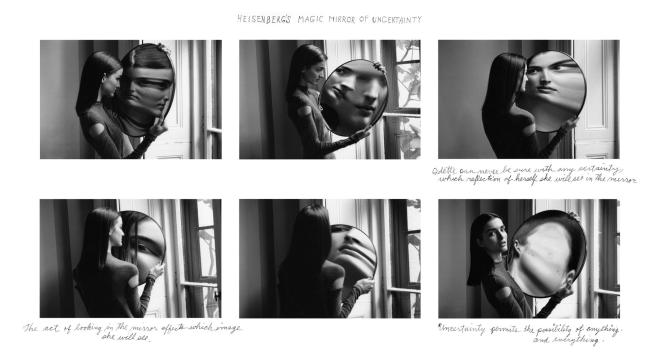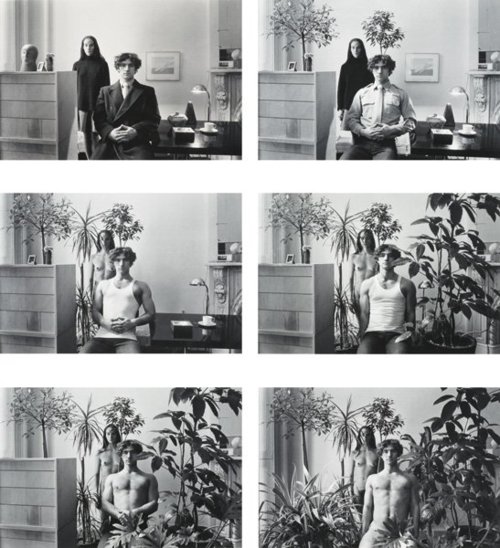“These enchanting photo sequences and montages, which are often accompanied by Michals’s handwritten prose, make innovative use of the medium’s ability to suggest what cannot be seen. “
 Duane Michals is an amazing story teller. His photos are so interesting to see, and read. It’s like the joy of reading the comic strips in childhood, but with much more melancholy, loving, serious and funny. Photos with a lot of handwritings explaining the story is something few people have ever did and I would really like to find out how he came up with the ideas. Then I found the following very interesting interview from New Yorker with Duane Michals where he briefly explained his ideas and thoughts in the work. It’s quite interesting to learn that this famous photographer did writing on his works because he found photographs themselves not expressive enough. But his explanation on his ideas on portraits is fascinating and worth reading.
Duane Michals is an amazing story teller. His photos are so interesting to see, and read. It’s like the joy of reading the comic strips in childhood, but with much more melancholy, loving, serious and funny. Photos with a lot of handwritings explaining the story is something few people have ever did and I would really like to find out how he came up with the ideas. Then I found the following very interesting interview from New Yorker with Duane Michals where he briefly explained his ideas and thoughts in the work. It’s quite interesting to learn that this famous photographer did writing on his works because he found photographs themselves not expressive enough. But his explanation on his ideas on portraits is fascinating and worth reading.

The Last Sentimentalist:
A Q. & A. with Duane Michals
Photographs by DUANE MICHALS/ Introduction by SIOBHAN BOHNACKER
Retrieved from: http://projects.newyorker.com/portfolio/michals-empty-ny/#8
What is important to you when you’re making a portrait?
I have a new concept. I call it the “prose portrait.” A prose portrait doesn’t necessarily show you what someone looks like; it’s not a line-for-line reproduction of a face. A prose portrait tells you what the nature of the person is about. When I photographed Magritte, the portrait was made in the nature of Magritte. When I photographed Warhol, the portrait was in the character, the mystery—if there is one—of Warhol. You can’t capture someone, per se. How could you? The subject probably doesn’t even know who he (or she) is. So, for me, a prose portrait is about a person, rather than of a person.
Writing plays a significant role in your photography. Most of your images are captioned with prose or poetry. Does this serve as an extension of your idea of a prose portrait?
My writing grew out of my frustration with photography. I never believed a photograph is worth a thousand words. If I took a picture of you, it would tell me nothing about your English accent; it would tell me nothing about you as a person. With somebody you know really well, it can be frustrating. Sixty per cent of my work is photography and the rest is writing.
Much of your work deals with mortality and the great question in life: Why? What compels you to return so often to this subject?
When I was making my book, “Questions Without Answers,” I said to my assistants, “Ask me questions, about life, about anything.” It never happened. Later, after I’d made the work for the book and held an exhibition, a critic said, “Who the hell is Duane Michals to ask these questions?” And my response was, Everybody should ask these questions. Every human being who is alive should ask these questions!
Fred has been diagnosed with Parkinson’s and Alzheimer’s, and has started saying the most wonderfully strange things. Recently, he said, “I saw you eating a banana. What was the meaning of that?” The other day, he quipped, “I wonder what Marco Polo’s doing,” and, “On holidays, everybody likes lemons.” There are so many of them and they’re so sweet.
We’ve been together for a long time, and I’ve known him over many incarnations. There’s the infatuation Fred, there’s the long-term Fred, and this is the last of the Freds. But of all of the Freds that I’ve known, this is maybe the best one. This is Fred exiting. There’s no subterfuge—he says exactly what he feels. [I] asked Fred, “Why do you think we’re here?” And he replied, “To take care of each other.” I thought that was brilliant. That’s the only meaning! Asked and answered.
You’re in your eighties now and still full of vitality. You’re eager to make art, to publish books, and to try new things. Do your ideas get more focussed as you grow older?
Yes, they do. What poetry is all about is paying attention to subtle details. Great art is paying attention to the things that are lost. When you are young, emotions are much broader; there’s that “anywhere you go, I will go with you” mentality. As you get older, it becomes more like tea that steeps for a long time and gets richer. That’s the sublime quality of life.
![ThisPhotographIsMyProof[1]](https://mitphoto2016.wordpress.com/wp-content/uploads/2016/04/thisphotographismyproof1.jpg?w=660)